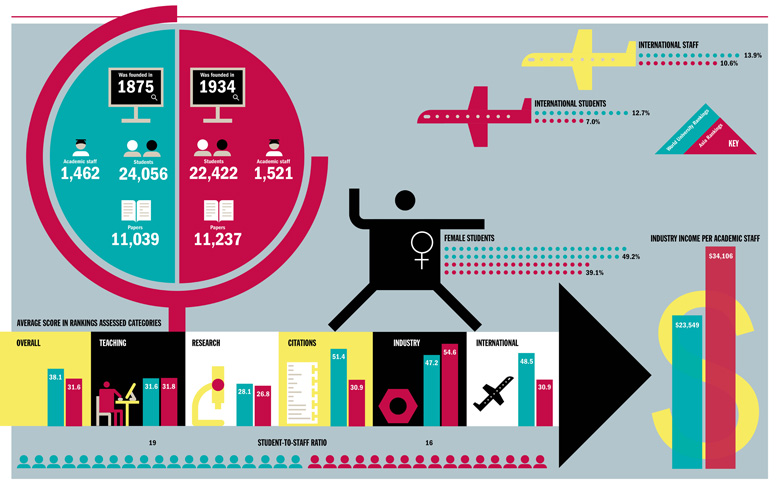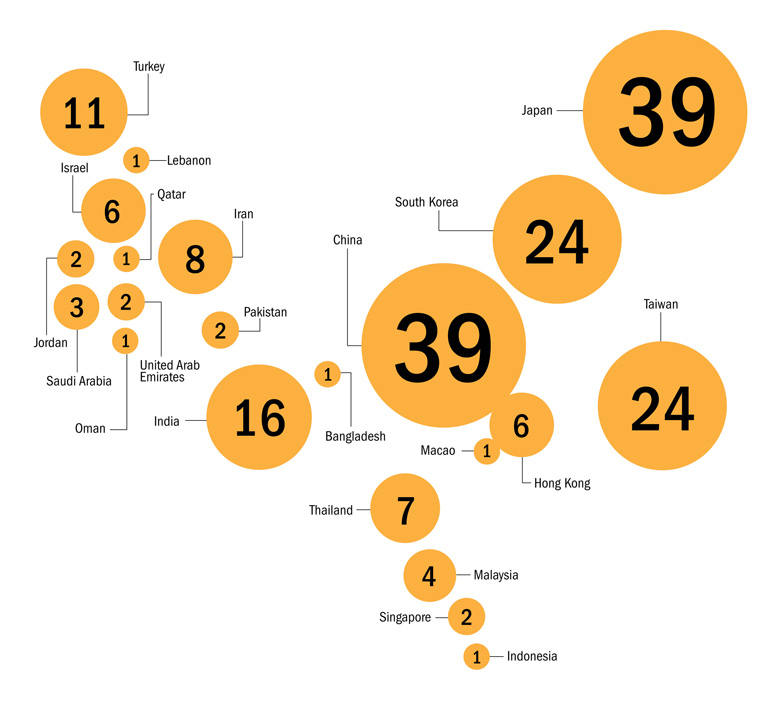The 2017 Asia University Rankings are out now
Singapore is home to the best two universities in Asia for the first time, while China and Japan have the highest density of top institutions in the continent, according to the Times Higher Education Asia University Rankings 2016.
The National University of Singapore (NUS) claims pole position, while its neighbour Nanyang Technological University (NTU) is in joint second place (with China’s Peking University) – the highest positions for the two Singaporean institutions in the rankings’ four-year history.
Singapore’s success in the table follows its rise in THE’s flagship World University Rankings; NUS has climbed 14 places in this table since 2012 to reach 26th place last year, while NTU has risen 119 places since 2011 to 55th place.
While mainland China and Japan are each home to almost a fifth of institutions in the extended top 200 table (39 each), China has the upper hand, after a shift in power towards the nation last year. The country has 22 universities in the top 100, including two in the top 10, while Japan has just 14 in the upper half of the table, and its top-ranked institution – the University of Tokyo in seventh place – has lost its place at the summit of the list.
- Strength in depth helps Asian universities rise up the rankings
- Malaysia must refocus to develop as a higher education power
- India leads in South Asia, but its neighbours are closing the gap
- The pillars of National University of Singapore’s success
Gerard Postiglione, chair professor in higher education at the University of Hong Kong, said that the Singaporean government’s “strategic” positioning of its universities as “competing in the global economy” and generous financial support for research are two reasons why the city state has “shone the brightest” in the ranking. He added that collaborations with world-class universities outside Asia – such as the partnership behind the Yale-NUS liberal arts college – have benefited Singapore’s universities.
“Singapore also has a very high-quality school system and its immigration policy makes it possible to bring in talented people,” he said.
China’s special administrative region, Hong Kong, has also performed well with six representatives, all in the top 45, while South Korea and Taiwan are the most-represented countries after China and Japan, with 24 institutions each.
Tony Chan, president of Hong Kong University of Science and Technology (HKUST), in sixth place, said that Hong Kong’s success is part of a “wider story about the rise of East Asia over the past few decades”.
- Asia takes the search for excellence seriously
- Don’t lose your head: rankings are but one measure of success
- Read more about the best universities in Asia for students
- Listen to the Asia University Rankings 2016 results podcast
“Being a gateway to mainland China and a melting pot of different cultures, Hong Kong, with its unique qualities including rule of law, low tax system, free flow of information, a skilled bilingual workforce and its world-class infrastructure, is the best breeding ground for knowledge and the advancement of science and technology – a reason why such a small city is home to several top universities in Asia,” he said.
Institutions from 22 countries, eight more than last year, feature in this year’s ranking, with several countries, including Bangladesh, Indonesia and Qatar, being represented for the first time.
The THE Asia University Rankings use the same 13 performance indicators as the World University Rankings, but have been recalibrated to reflect the attributes of Asia’s higher education systems.
Claim a free copy of the full Asia University Rankings 2016 digital supplement
Asia University Rankings 2016: top 10
| 2016 Asia rank | World University Rank 2015-16 | Institution | Country |
| 1 | 26 | National University of Singapore | Singapore |
| =2 | 55 | Nanyang Technological University | Singapore |
| =2 | 42 | Peking University | China |
| 4 | =44 | University of Hong Kong | Hong Kong |
| 5 | =47 | Tsinghua University | China |
| 6 | 59 | Hong Kong University of Science and Technology | Hong Kong |
| 7 | 43 | University of Tokyo | Japan |
| 8 | 116 | Pohang University of Science and Technology | South Korea |
| 9 | 85 | Seoul National University | South Korea |
| 10 | 148 | Korea Advanced Institute of Science and Technology (KAIST) | South Korea |
Browse the full list of the top 200 institutions in this year's rankings
‘Mind over muscle’: the simple recipe for Singapore’s success
The city state’s capacity to punch above its weight stems from its determination to compete with the best in the world, writes Ellie Bothwell
When Bertil Andersson, president of Singapore’s Nanyang Technological University, was recently asked to explain how the country has improved its universities, he pointed to the government “walking the talk” when it comes to funding research and academia.
“Singapore is one of the countries that, in the past 10 or 15 years has invested maybe the most in academic research globally, if you compare it to the size of the country,” he told the International Higher Education Forum in London earlier this year.
He cited Singapore’s rise up the Times Higher Education World University Rankings as evidence of the country’s higher education success. Since 2011, NTU has risen 119 places to reach 55th in the 2015‑16 rankings, while the National University of Singapore has climbed 14 places since 2012 to reach 26th place.
Singapore has made another big leap this year. The city state claims the top two spots in the THE Asia University Rankings 2016 for the first time in the table’s four-year history. NUS and NTU both achieve very high scores for international outlook. Top-ranked NUS also achieves the highest score for research in the 200-strong list, while NTU, in joint second place (with China’s Peking University), scores the best on research influence (citations).
Simon Marginson, professor of international higher education at the UCL Institute of Education, says that Singapore’s success is “not bad for an island state of 5.5 million people”, adding that there are 30 cities in Asia larger than Singapore.
The city state’s rankings achievement “underlines the remarkable success of Singapore’s global strategy” and represents “a case of mind over muscle”, he says.
“Singapore’s strategy of intensive internationalisation, benchmarking against the world’s best universities, and targeting and attracting talented researchers, has paid off,” he explains.
“It is especially impressive to see the recent rise of Nanyang, which is stronger than NUS in citations per faculty and industry links.
“In fact, if it wasn’t for the older and larger NUS’ reputation, which powers its position in the survey for research and teaching excellence, Nanyang might have pipped NUS for the top spot.”
The THE Asia University Rankings use the same 13 performance indicators as the flagship World University Rankings, but for the first time this year the indicator weightings have been modified, following consultation with Asian institutions.
The weight given to academic reputation has been significantly reduced to reflect the fact that many Asian institutions have only relatively recently arrived on the world stage, with investment focused on recent decades, so have had less time to accumulate reputation around the world.
More weight is given to the industry-income indicator to reflect the fact that many Asian nations have put their universities at the forefront of economic growth plans, where industry links are crucial.
While Singapore is home to Asia’s top two universities, the strongest nation overall is China. Mainland China together with Hong Kong claim 45 places in the extended top 200 table (which has been expanded from 100 last year). Peking University shares second place with NTU, while the University of Hong Kong, Tsinghua University and Hong Kong University of Science and Technology take fourth, fifth and sixth places, respectively.
Japan has the same number of representatives as mainland China – 39 – but its universities are lower down the list. It has 14 institutions in the top 100, compared with 22 in mainland China, and just one in the top 10 – the University of Tokyo, in seventh place.
Marginson notes that the rise of China and the “weakening of Japan’s comparative position” is “a big change from five years ago”.
“Japan is paying the price for two decades of constrained university funding while China has built the C9 group [an alliance of nine elite universities] through the 985 programme,” he says.
Mean positions
How the average institution in the Asia University Rankings 2016 compares with the average in the top 800 in the World University Rankings 2015-16
“Japan’s special funding programmes for global competition and internationalisation are on a much smaller scale and operate as compensation for underfunding rather than creating new value.
“The other factor working in China’s favour is the survey element – China’s reputation for higher education and science has risen, and this powers a further lift.”
He adds that Hong Kong’s universities have also been well funded, but “without the same super-injection of funds”.
“The system is astutely managed by the Hong Kong University Grants Committee, whose policies have ensured that Hong Kong has five world-class research universities of roughly equal size, with a good balance of strength between them,” he says.
Taiwan and South Korea are the third most-represented nations with 24 institutions each.
One common characteristic of the leading nations in the table is the launch of government initiatives aimed at promoting world-class universities.
Jamil Salmi, former coordinator of the World Bank’s tertiary education programme, says that of these regional “excellence initiatives”, China’s efforts “have been most impressive”. He highlights government reforms in 1993 and 1998, the latter of which saw the announcement of the goal of building world-class universities with a clear emphasis on the advancement of science and technology.
“Since then, state funding for tertiary education has more than doubled, reaching almost 1 per cent of gross domestic product,” he says.
Last year the Chinese government also launched a new excellence initiative – dubbed “World Class 2.0” – aimed at establishing six of its universities in the leading group of global institutions by 2020, and for some of those to reach top 15 status by 2030.
Salmi says that to support these ambitions, Chinese universities “have spent millions of dollars to recruit internationally renowned, foreign-trained Chinese and Chinese-American scholars and to build state-of-the-art research laboratories, particularly in science and technology”.
“The strategy is to surround their star faculties with the brightest students, give them academic leeway and provide competitive remuneration packages,” he says.
“With low labour costs, structural upgrades are achievable at a 10th of the cost of those in industrial countries. All this is happening in the context of a new regime of financial autonomy, significant cost sharing, and intense efforts to develop management expertise at all levels of university leadership.”
He adds that the South Koreans have also been “quite good on the internationalisation front, by relying effectively on the diaspora, inviting foreign researchers to their universities and multiplying the number of programmes taught in English”.
Chung Kyu Sang, president of Sungkyunkwan University, in 12th place, admits that internationalisation was a “weak side” of South Korea’s higher education system, particularly compared with Singapore and Hong Kong, but that recent investment in this area has raised its international reputation.
He adds that his own institution has recruited former company executives as professors to strengthen industry-university cooperation.
“As a result, Sungkyunkwan University has attained 329.4 billion won [£195 million] in research funding, which has increased significantly since 2010 when it was at 219.9 billion won,” he says.
However, Terri Kim, reader in comparative higher education at the University of East London, says that while a number of leading foreign academics had been lured to work at top South Korean universities following major government funding injections, many have since terminated their contracts and left the country.
Education nations
The countries of the continent by the number of institutions represented in the Asia University Rankings 2016
“International students and staff are treated as guests and they are not really part of the local system, so there is a sense of exclusion, or non-inclusion, all the time,” she says.
Part of the reason for this, she explains, is that South Korea was never a Western colony, unlike many of its neighbours, meaning that the country has not had the same history of “accommodating Western cultural standards” as other countries in Asia.
She adds: “The culture of faculty doesn’t change with government policy. On a day-to-day basis, inside the classrooms and inside the laboratories, the old practice continues.”
While East Asian universities dominate this ranking, institutions in other parts of the continent are becoming more visible, in part because the list has doubled to 200 this year. This means that 16 Indian universities are represented compared with just nine last year, while Turkey has 11, up from six. Bangladesh, Indonesia, Oman, Qatar, Jordan and Pakistan all make the table for the first time.
Israel has also increased its share, irrespective of the newly extended list. It has six institutions in the top 100 compared with just four last year and three in 2014, led by the Hebrew University of Jerusalem in joint 17th place.
Its president, Menahem Ben-Sasson, says the institution’s main strength is that its staff and students “are never satisfied with the status quo”. He adds that the university “produces about a third of the research output in Israel”, while another hallmark of its success is the conversion of research into patents, licences and spin-off companies through its technology transfer company Yissum.
“You would be surprised to know how many products that come your way originated at the Hebrew University – everything from Alzheimer’s drugs to cherry tomatoes and computerised driver-safety systems,” he says.
However, it is still a challenge letting the world know that “we are one of the best academic and research institutions in the world”, Ben-Sasson says.
“While we are not sitting in better-known locations like the US, the UK or Australia, Jerusalem is both an ancient and ultra-modern city that is an incredible place for students to live and study,” he says.
“A place like the Hebrew University is a special environment where people of all backgrounds – Jews, Muslims, Christians, atheists and others – can live and study side by side regardless of what’s happening in society.”
If there is one “single lesson” from this ranking, concludes Marginson, it is that “nations that invest heavily and carefully in building science and world-class universities will gain performance and recognition down the track”.
“Japan did so in the 1960s to 1980s and still has impressive capability in its top universities. Singapore, Taiwan and Korea invested heavily from the 1990s onwards; and China has famously done so since the late 1990s,” he says.
But will Asia’s increased and focused investment in higher education see some of the continent’s universities competing with the global elite in the near future?
“The top 20 or so in Asia are becoming strong in world terms – NUS in Singapore already produces two-thirds as many high-citation research papers as [the University of] Cambridge – and will be able to challenge the top group of universities in Europe in another generation if present trends continue,” predicts Marginson.
“The top Americans remain out of reach for the foreseeable future, but the large number of second-level universities in China is beginning to resemble the US system.
“Given the present levels of investment in higher education, which are still rising, we can be sure that a lot more improvement is in the pipeline.”
Register to continue
Why register?
- Registration is free and only takes a moment
- Once registered, you can read 3 articles a month
- Sign up for our newsletter
Subscribe
Or subscribe for unlimited access to:
- Unlimited access to news, views, insights & reviews
- Digital editions
- Digital access to THE’s university and college rankings analysis
Already registered or a current subscriber?













